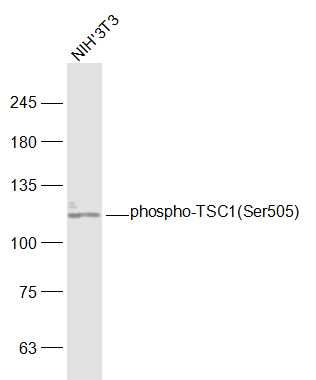产品货号 : mlR5600
英文名称 : phospho-TSC1 (Ser505)
中文名称 : 磷酸化结节性硬化症蛋白1抗体
别 名 : TSC1(phospho S505); TSC1(phospho Ser505); LAM; TSC1; Tuberous sclerosis 1 protein; TSC1_HUMAN; KIAA0243; TSC; Tuberous sclerosis 1.
产品类型 : 磷酸化抗体
研究领域 : 肿瘤 免疫学 染色质和核信号
抗体来源 : Rabbit
克隆类型 : Polyclonal
交叉反应 : Human, Mouse, Rat, Chicken, Dog, Pig, Cow, Horse, Rabbit,
产品应用 : WB=1:500-2000 ELISA=1:500-1000 IHC-P=1:400-800 IHC-F=1:400-800 IF=1:100-500 (石蜡切片需做抗原修复)
not yet tested in other applications.
optimal dilutions/concentrations should be determined by the end user.
分 子 量 : 128kDa
细胞定位 : 细胞浆 细胞膜
性 状 : Lyophilized or Liquid
浓 度 : 1mg/ml
免 疫 原 : KLH conjugated Synthesised phosphopeptide derived from human TSC1 around the phosphorylation site of Ser505:FD(p-S)PF
亚 型 : IgG
纯化方法 : affinity purified by Protein A
储 存 液 : 0.01M TBS(pH7.4) with 1% BSA, 0.03% Proclin300 and 50% Glycerol.
保存条件 : Store at -20 °C for one year. Avoid repeated freeze/thaw cycles. The lyophilized antibody is stable at room temperature for at least one month and for greater than a year when kept at -20°C. When reconstituted in sterile pH 7.4 0.01M PBS or diluent of antibody the antibody is stable for at least two weeks at 2-4 °C.
PubMed : PubMed
产品介绍background:
Hamartin, or TSC1, is a suspected tumor suppressor implicated in the disease tuberous sclerosis 1. It is a negative regulator of cell division controlling the transition from G0/G1 to S phase, and it seems to act through the phosphatidylinositol 3 kinase/Akt pathway. TSC1 interacts with tuberin m(TSC2), which is thought to be a GAP (GTPase Activating Protein) for the Rap1 and Rab5 small G Proteins. The Hamartin/Tuberin complex has been shown to inhibit mTor. Hamartin has also been shown to interact with ERM (Ezrin-Radixin-Moesin) proteins and with F-actin, suggesting a role for TSC proteins in modulation of cell adhesion and morphology.
Function:
In complex with TSC2, inhibits the nutrient-mediated or growth factor-stimulated phosphorylation of S6K1 and EIF4EBP1 by negatively regulating mTORC1 signaling. Seems not to be required for TSC2 GAP activity towards RHEB. Implicated as a tumor suppressor. Involved in microtubule-mediated protein transport, but this seems to be due to unregulated mTOR signaling.
Subunit:
Interacts with TSC2, leading to stabilize TSC2. In the absence of TSC2, TSC1 self-aggregates. Interacts with DOCK7. Interacts with FBXW5 and TBC1D7.
Subcellular Location:
Cytoplasm. Membrane; Peripheral membrane protein. Note=At steady state found in association with membranes.
Tissue Specificity:
Highly expressed in skeletal muscle, followed by heart, brain, placenta, pancreas, lung, liver and kidney. Also expressed in embryonic kidney cells.
Post-translational modifications:
Phosphorylation at Ser-505 does not affect interaction with TSC2. Phosphorylated upon DNA damage, probably by ATM or ATR.
DISEASE:
Defects in TSC1 are the cause of tuberous sclerosis type 1 (TSC1) [MIM:191100]. It is an autosomal dominant multi-system disorder that affects especially the brain, kidneys, heart, and skin. TS1C is characterized by hamartomas (benign overgrowths predominantly of a cell or tissue type that occurs normally in the organ) and hamartias (developmental abnormalities of tissue combination). Clinical symptoms can range from benign hypopigmented macules of the skin to profound mental retardation with intractable seizures to premature death from a variety of disease-associated causes.
Defects in TSC1 may be a cause of focal cortical dysplasia of Taylor balloon cell type (FCDBC) [MIM:607341]. FCDBC is a subtype of cortical displasias linked to chronic intractable epilepsy. Cortical dysplasias display a broad spectrum of structural changes, which appear to result from changes in proliferation, migration, differentiation, and apoptosis of neuronal precursors and neurons during cortical development.
SWISS:
Q92574
Gene ID:
7248
Important Note:
This product as supplied is intended for research use only, not for use in human, therapeutic or diagnostic applications.
结节性硬化症为常染色体显性遗传,也常见散发病例。是肿瘤抑制基因,基因产物分别为Hamartin和tuberin,两者均调节细胞生长。
结节性硬化症(tuberous sclerosis)又称结节性脑硬化,Bourneville病。本病可归类于神经皮肤综合征(亦称斑痣性错构瘤病),是源于外胚层的器官发育异常所致,病变累及神经系统、皮肤和眼,也可累及中胚层,内胚层器官如心、肺、骨,肾和胃肠等。皮脂腺瘤是皮肤神经末梢、增生的结缔组织和血管组成,视网膜可见胶质瘤、神经节细胞瘤,心、肾、肺、肝脏等也可发生肿瘤。
而神经胶质增生性硬化结节广泛发生于大脑皮质、白质、基底节和室管膜下,常伴钙质沉积,可出现一位症及血管增生等,出现癫痫发作及智能减退为特征。
产品图片












